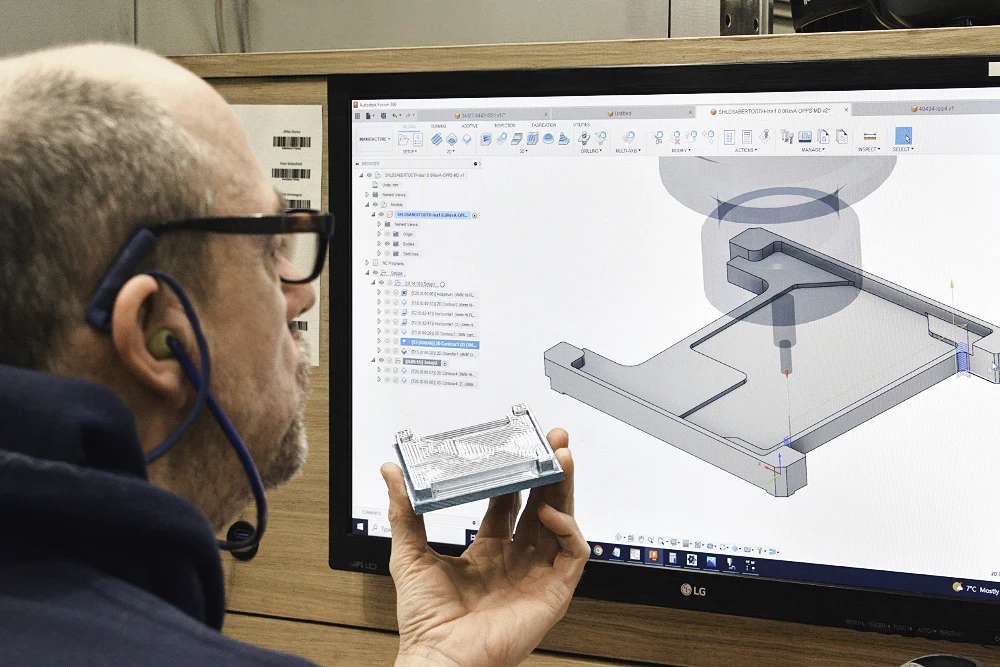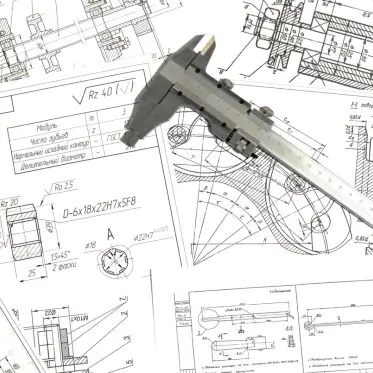 Get a quote
Get a quote
Design for Manufacturing (DFM) is about designing parts that are simpler, faster, and more economical to produce. It includes streamlining geometry, selecting the right materials, and involving manufacturers early to avoid production issues.
Design for Manufacturing (DFM) helps you make smart decisions early so your product is easier, faster, and more cost-effective to produce. It’s about aligning your design with real-world production methods before any material is cut or shaped. Whether you're refining a prototype or preparing for full-scale manufacturing, DFM plays a key role in getting it right the first time.
This guide covers what is DFM, DFM meaning, how it fits into engineering and manufacturing, and how to improve your design so it’s ready for efficient production. It also explains common design challenges and how to avoid them through better collaboration. By the end, you’ll know how to apply DFM to create parts that work better and cost less to make.
DFM is the practice of designing products with the manufacturing process in mind from the very beginning. Instead of designing first and solving production issues later, you make early choices that suit the machines, materials, and methods used to bring your design to life. It’s a key part of what is design and manufacture in today’s fast-moving industries.
By thinking ahead, you avoid unnecessary costs, delays, and last-minute changes. Design adjustments are far easier and cheaper to make before production starts. That’s why successful teams always include DFM from the earliest design stages.
The aim of DFM is to reduce cost and complexity without compromising on performance. You do this by carefully considering part shape, size, material selection, and how each component will be made. These design choices help speed up production and reduce the risk of errors or waste.
Think of DFM as a way to make your design work better in the real world. If a feature is difficult or costly to machine, it can be improved early on. This helps prevent delays, redesigns, and unexpected costs once production is underway.
DFM principles help you turn your ideas into parts that are easier to make, assemble, and scale. These guidelines apply whether you're producing a handful of components or preparing for full-volume manufacturing. A few smart choices at the design stage can have a big impact on cost, quality, and time.
Simpler designs are faster to produce, more reliable, and usually cost less. Reducing part count or combining functions into fewer components saves time, tooling, and material. It also removes unnecessary complexity that can lead to machining delays or assembly errors.
For example, replacing several brackets with a single machined piece reduces both production and fitting time. You also minimise risks from tolerance stack-ups or mismatched parts. Even small changes like these can add up to big savings over a production run.
Common simplification tips include:
Standard components are easier to source and more predictable in both cost and quality. Using off-the-shelf parts like screws, fasteners, or connectors keeps your design simple and supply chains more reliable. This is especially helpful if you need to replace something quickly or scale up production.
Imagine needing a replacement mid-project, finding a standard M5 bolt is much easier than sourcing a custom-machined pin. Manufacturers often have better pricing and availability on parts they already use. Where possible, choose standard over custom to keep things moving smoothly.
Choosing the right material means balancing performance, cost, and manufacturability. Aluminium, for example, is lightweight and easy to machine, while PEEK might be ideal for high-performance medical or aerospace components. Think beyond just price — consider how your material behaves during machining and in its final environment.
Talk to your supplier to see what materials they already stock or recommend. Sometimes, a similar alternative can reduce lead times and save money without affecting performance. The right choice depends on both the part's function and the production method you plan to use.
Material considerations may include:
Making your parts easier to assemble saves time and reduces errors. Self-aligning features, clips, or tabs can often replace screws, glue, or more complex joints. The fewer tools and steps required, the smoother your production process will be.
Imagine an assembly operator building 100 parts a day, shaving off a few seconds per part adds up quickly. Simple changes like adding chamfers, notches, or snap fits can reduce both labour and defects. Always look for ways to make life easier on the shop floor.
Tips for better assembly:
It’s easy to assume tighter tolerances are always better, but that’s not always true in practice. Unnecessarily tight tolerances can slow down production, increase cost, and cause parts to be scrapped even if they work fine. Tolerances should match what the part actually needs to function, no tighter.
Ask your machinist what’s realistic for the process and material you’re using. If a tight tolerance isn’t essential, loosening it could speed up production and reduce costs. Good tolerancing is about balancing precision with practicality.
Smart tolerancing helps:
So, what is DFM in engineering? It’s about making smart design decisions that balance aesthetic and functionality and reflect the realities of machining, not just ideal CAD models. Engineers use DFM to find out if things can be made better, faster, or at a lower cost without compromising their purpose.
This is where hands-on experience really counts. A design might look perfect on screen but require multiple complex setups to machine in practice. That’s why it’s important to review designs with experts in CNC machining services for product design who understand how to spot tricky features and streamline production.
Good DFM isn’t just theory, it’s a practical process you apply throughout your design and production journey. It involves close collaboration with suppliers, regular design reviews, and validating parts through prototyping. These steps help reduce risk, save time, and lead to stronger outcomes.
Involving your manufacturer early in the process is one of the most effective ways to apply DFM. They can highlight costly features, suggest more suitable materials, or recommend easier ways to produce certain elements. Early input helps prevent delays and ensures everyone is working toward a design that’s practical and efficient.
Cross-functional collaboration leads to better parts and smoother workflows. At Penta, for example, we support early-stage reviews to help optimise designs before any machining begins. This proactive approach helps reduce changes later and keeps projects on track.
Build DFM into every stage of your design review process. Ask your team questions like: Are we using hard-to-machine features? Could a design detail be simplified or replaced with a more standard option?
A structured design for manufacturability checklist helps you catch issues early. It ensures every element, from tolerances to material choice, is suited to production. This leads to easier machining, fewer revisions, and more consistent results. For example, enclosure designs often involve a combination of machining, fit, and accessibility needs.
A basic checklist may include:
Applying DFM in prototyping reduces the need for redesigns and avoids production issues later. It leads to more accurate testing, faster turnaround, and better product validation. Using prototype machining for design validation helps ensure your design is functional, manufacturable, and ready to scale.
Real prototypes often reveal issues that don’t show up in drawings. You might find weak areas, difficult machining paths, or setup challenges. Catching these early helps ensure your production run goes smoothly.
DFM doesn’t stop after launch, the best designs evolve over time. Each production cycle offers new insights into how parts can be made more efficiently or cost-effectively. Stay open to feedback from machinists, suppliers, and end users to keep improving.
Maybe there’s an opportunity to reduce setups by tweaking a hole size. Or perhaps a more common material could replace a high-cost alloy without performance loss. Every small improvement brings you closer to a leaner, smarter product.
Designing with manufacturing in mind helps speed up your process, cut costs, and improve the final product. It means fewer redesigns, fewer errors, and more efficient production overall. By solving issues early, you reduce waste and avoid costly surprises down the line.
Working with suppliers is easier when your drawings reflect real-world capabilities. It leads to better communication, faster quoting, and stronger working relationships. The end result is a smoother path from concept to delivery.
Top DFM benefits:
DFM and DFA focus on different parts of the production process but work best when used together. DFM is about designing parts that are easy and cost-effective to make, while DFA focuses on how those parts fit together during assembly. Together, they form DFMA, a combined approach that supports smooth, efficient production from start to finish.
For example, DFM might recommend simplifying part geometry, while DFA looks at reducing the number of fasteners or tools required. Each method helps lower cost and improve build speed in its own way. Used together, they help you design smarter and deliver better results.
Design choices made early in development have the biggest impact on production success. That’s why DFM matters, it builds efficiency into your process before any material is ordered or cut. By applying DFM, you set your project up for faster, more reliable outcomes.
Whether you're building a single prototype or preparing for high-volume output, DFM helps reduce waste, improve quality, and hit your targets. At Penta Precision, we support this with expert machining advice, tooling solutions, and a detailed machining drawing service that ensures your design is production-ready. When DFM is part of the process, your product is built to succeed.
Getting manufacturers involved early helps identify issues before production begins. This allows for faster design adjustments and prevents costly last-minute changes. Early collaboration leads to a smoother transition from design to finished part.
Tight tolerances, deep pockets, sharp corners, and undercuts all make machining more complex and time-consuming. Simplifying features and using standard dimensions can reduce production time and cost. It�s always worth checking with your machinist before finalising detailed designs.
Applying DFM in prototyping reduces the need for redesigns and avoids production issues later. It leads to more accurate testing, faster turnaround, and better product validation. This saves time, minimises waste, and supports smoother scaling.
Suppliers understand what works best with their tools, materials, and workflows. Their input helps optimise your design for real-world production without trial and error. Involving them early ensures stronger results and avoids avoidable complications.
Designs that follow DFM principles are easier to replicate consistently in larger batches. Features like standard holes, simplified geometry, and logical assembly steps speed up production. This lowers unit cost and makes it easier to meet demand.

Discover essential tips for optimising lead times in precision machining, including effective design practices and alternative buying methods. Learn how Penta Precision can streamline your CNC machining projects for faster delivery and improved efficiency.

You love the brushed aluminium finish on your top-of-the-range designer laptop. And you want the same finish for the high-end medical device you're specifying. But this may not be as easy as you think. The aluminium grade you want may not be readily available. Or the finishing may require special techniques.